child restraint Seat Leon 5D 2008 Owner's manual
[x] Cancel search | Manufacturer: SEAT, Model Year: 2008, Model line: Leon 5D, Model: Seat Leon 5D 2008Pages: 293, PDF Size: 8.67 MB
Page 4 of 293
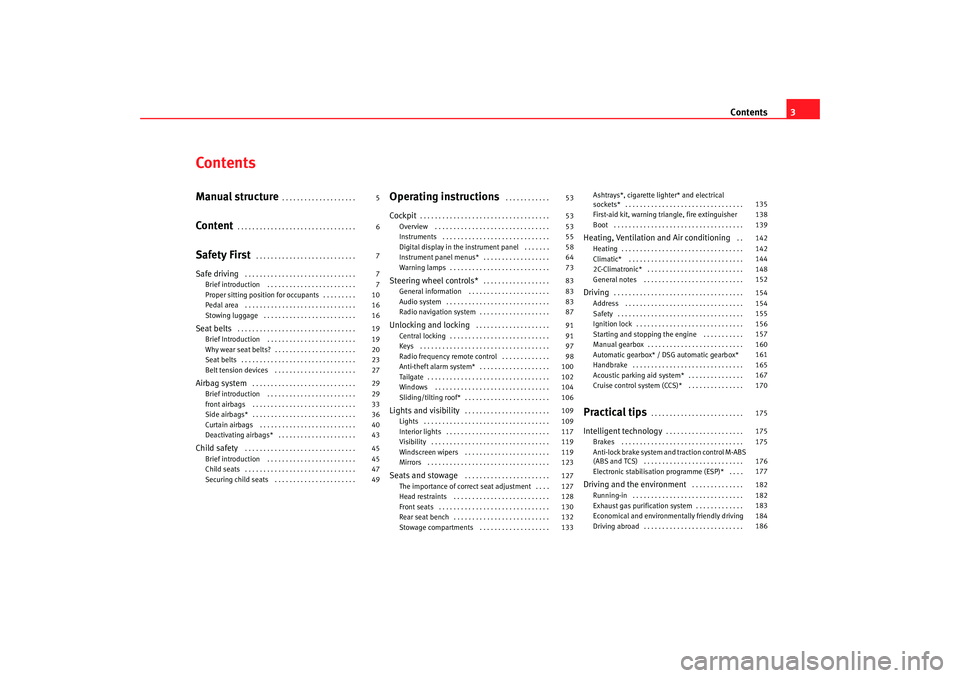
Contents3
ContentsManual structure
. . . . . . . . . . . . . . . . . . . .
Content
. . . . . . . . . . . . . . . . . . . . . . . . . . . . . . . .
Safety First
. . . . . . . . . . . . . . . . . . . . . . . . . . .
Safe driving
. . . . . . . . . . . . . . . . . . . . . . . . . . . . . .
Brief introduction . . . . . . . . . . . . . . . . . . . . . . . .
Proper sitting position for occupants . . . . . . . . .
Pedal area . . . . . . . . . . . . . . . . . . . . . . . . . . . . . .
Stowing luggage . . . . . . . . . . . . . . . . . . . . . . . . .
Seat belts
. . . . . . . . . . . . . . . . . . . . . . . . . . . . . . . .
Brief Introduction . . . . . . . . . . . . . . . . . . . . . . . .
Why wear seat belts? . . . . . . . . . . . . . . . . . . . . . .
Seat belts . . . . . . . . . . . . . . . . . . . . . . . . . . . . . . .
Belt tension devices . . . . . . . . . . . . . . . . . . . . . .
Airbag system
. . . . . . . . . . . . . . . . . . . . . . . . . . . .
Brief introduction . . . . . . . . . . . . . . . . . . . . . . . .
front airbags . . . . . . . . . . . . . . . . . . . . . . . . . . . .
Side airbags* . . . . . . . . . . . . . . . . . . . . . . . . . . . .
Curtain airbags . . . . . . . . . . . . . . . . . . . . . . . . . .
Deactivating airbags* . . . . . . . . . . . . . . . . . . . . .
Child safety
. . . . . . . . . . . . . . . . . . . . . . . . . . . . . .
Brief introduction . . . . . . . . . . . . . . . . . . . . . . . .
Child seats . . . . . . . . . . . . . . . . . . . . . . . . . . . . . .
Securing child seats . . . . . . . . . . . . . . . . . . . . . .
Operating instructions
. . . . . . . . . . . .
Cockpit
. . . . . . . . . . . . . . . . . . . . . . . . . . . . . . . . . . .
Overview . . . . . . . . . . . . . . . . . . . . . . . . . . . . . . .
Instruments . . . . . . . . . . . . . . . . . . . . . . . . . . . . .
Digital display in the instrument panel . . . . . . .
Instrument panel menus* . . . . . . . . . . . . . . . . . .
Warning lamps . . . . . . . . . . . . . . . . . . . . . . . . . . .
Steering wheel controls*
. . . . . . . . . . . . . . . . . .
General information . . . . . . . . . . . . . . . . . . . . . .
Audio system . . . . . . . . . . . . . . . . . . . . . . . . . . . .
Radio navigation system . . . . . . . . . . . . . . . . . . .
Unlocking and locking
. . . . . . . . . . . . . . . . . . . .
Central locking . . . . . . . . . . . . . . . . . . . . . . . . . . .
Keys . . . . . . . . . . . . . . . . . . . . . . . . . . . . . . . . . . .
Radio frequency remote control . . . . . . . . . . . . .
Anti-theft alarm system* . . . . . . . . . . . . . . . . . . .
Tailgate . . . . . . . . . . . . . . . . . . . . . . . . . . . . . . . . .
Windows . . . . . . . . . . . . . . . . . . . . . . . . . . . . . . .
Sliding/tilting roof* . . . . . . . . . . . . . . . . . . . . . . .
Lights and visibility
. . . . . . . . . . . . . . . . . . . . . . .
Lights . . . . . . . . . . . . . . . . . . . . . . . . . . . . . . . . . .
Interior lights . . . . . . . . . . . . . . . . . . . . . . . . . . . .
Visibility . . . . . . . . . . . . . . . . . . . . . . . . . . . . . . . .
Windscreen wipers . . . . . . . . . . . . . . . . . . . . . . .
Mirrors . . . . . . . . . . . . . . . . . . . . . . . . . . . . . . . . .
Seats and stowage
. . . . . . . . . . . . . . . . . . . . . . .
The importance of correct seat adjustment . . . .
Head restraints . . . . . . . . . . . . . . . . . . . . . . . . . .
Front seats . . . . . . . . . . . . . . . . . . . . . . . . . . . . . .
Rear seat bench . . . . . . . . . . . . . . . . . . . . . . . . . .
Stowage compartments . . . . . . . . . . . . . . . . . . . Ashtrays*, cigarette lighter* and electrical
sockets* . . . . . . . . . . . . . . . . . . . . . . . . . . . . . . . .
First-aid kit, warning triangle, fire extinguisher
Boot . . . . . . . . . . . . . . . . . . . . . . . . . . . . . . . . . . .
Heating, Ventilation and Air conditioning
. .
Heating . . . . . . . . . . . . . . . . . . . . . . . . . . . . . . . . .
Climatic* . . . . . . . . . . . . . . . . . . . . . . . . . . . . . . .
2C-Climatronic* . . . . . . . . . . . . . . . . . . . . . . . . . .
General notes . . . . . . . . . . . . . . . . . . . . . . . . . . .
Driving
. . . . . . . . . . . . . . . . . . . . . . . . . . . . . . . . . . .
Address . . . . . . . . . . . . . . . . . . . . . . . . . . . . . . . .
Safety . . . . . . . . . . . . . . . . . . . . . . . . . . . . . . . . . .
Ignition lock . . . . . . . . . . . . . . . . . . . . . . . . . . . . .
Starting and stopping the engine . . . . . . . . . . .
Manual gearbox . . . . . . . . . . . . . . . . . . . . . . . . . .
Automatic gearbox* / DSG automatic gearbox*
Handbrake . . . . . . . . . . . . . . . . . . . . . . . . . . . . . .
Acoustic parking aid system* . . . . . . . . . . . . . . .
Cruise control system (CCS)* . . . . . . . . . . . . . . .
Practical tips
. . . . . . . . . . . . . . . . . . . . . . . . .
Intelligent technology
. . . . . . . . . . . . . . . . . . . . .
Brakes . . . . . . . . . . . . . . . . . . . . . . . . . . . . . . . . .
Anti-lock brake system and traction control M-ABS
(ABS and TCS) . . . . . . . . . . . . . . . . . . . . . . . . . . .
Electronic stabilisation programme (ESP)* . . . .
Driving and the environment
. . . . . . . . . . . . . .
Running-in . . . . . . . . . . . . . . . . . . . . . . . . . . . . . .
Exhaust gas purification system . . . . . . . . . . . . .
Economical and environmentally friendly driving
Driving abroad . . . . . . . . . . . . . . . . . . . . . . . . . . .
5
6
7
7
7
10
16
16
19
19
20
23
27
29
29
33
36
40
43
45
45
47
49 53
53
53
55
58
64
73
83
83
83
87
91
91
97
98
100
102
104
106
109
109
117
119
119
123
127
127
128
130
132
133 135
138
139
142
142
144
148
152
154
154
155
156
157
160
161
165
167
170
175
175
175
176
177
182
182
183
184
186
leon_ingles Seite 3 Mont
ag, 26. Januar 2009 4:29 16
Page 8 of 293
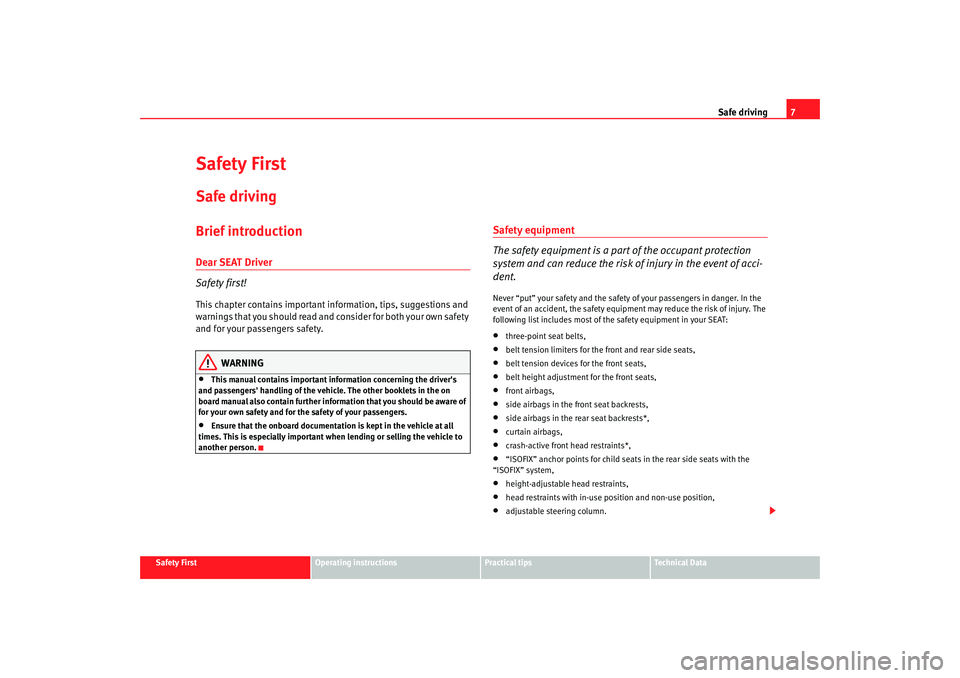
Safe driving7
Safety First
Operating instructions
Practical tips
Te c h n i c a l D a t a
Safety FirstSafe drivingBrief introductionDear SEAT Driver
Safety first!This chapter contains important information, tips, suggestions and
warnings that you should read and consider for both your own safety
and for your passengers safety.
WARNING
•
This manual contains important info rmation concerning the driver's
and passengers' handling of the vehicle. The other booklets in the on
board manual also contain further information that you should be aware of
for your own safety and for the safety of your passengers.
•
Ensure that the onboard documentatio n is kept in the vehicle at all
times. This is especially important when lending or selling the vehicle to
another person.
Safety equipment
The safety equipment is a part of the occupant protection
system and can reduce the risk of injury in the event of acci-
dent.Never “put” your safety and the safety of your passengers in danger. In the
event of an accident, the safety equipment may reduce the risk of injury. The
following list includes most of the safety equipment in your SEAT:•
three-point seat belts,
•
belt tension limiters for the front and rear side seats,
•
belt tension devices for the front seats,
•
belt height adjustment for the front seats,
•
front airbags,
•
side airbags in the front seat backrests,
•
side airbags in the rear seat backrests*,
•
curtain airbags,
•
crash-active front head restraints*,
•
“ISOFIX” anchor points for child seats in the rear side seats with the
“ISOFIX” system,
•
height-adjustable head restraints,
•
head restraints with in-use position and non-use position,
•
adjustable steering column.
leon_ingles Seite 7 Mont ag, 26. Januar 2009 4:29 16
Page 9 of 293
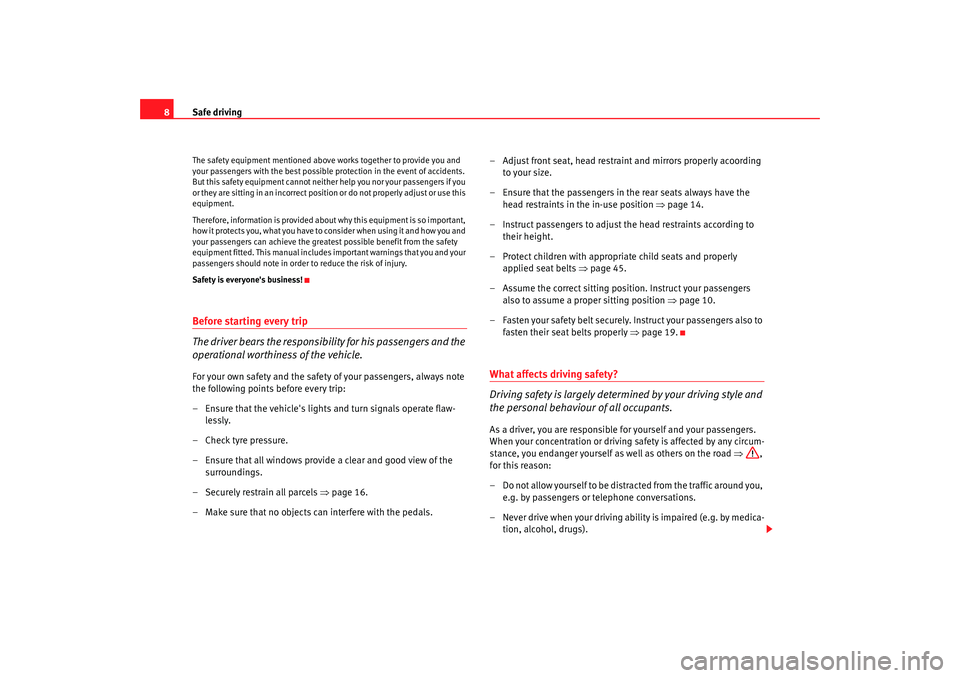
Safe driving
8The safety equipment mentioned above works together to provide you and
your passengers with the best possible protection in the event of accidents.
But this safety equipment cannot neither help you nor your passengers if you
or they are sitting in an incorrect position or d o not pro per ly adjust o r use this
equipment.
Therefore, information is provided about why this equipment is so important,
how it protects you, what you have to consider when using it and how you and
your passengers can achieve the greatest possible benefit from the safety
equipment fitted. This manual includes important warnings that you and your
passengers should note in order to reduce the risk of injury.
Safety is everyone's business!Before starting every trip
The driver bears the responsibility for his passengers and the
operational worthiness of the vehicle.For your own safety and the safety of your passengers, always note
the following points before every trip:
– Ensure that the vehicle's lights and turn signals operate flaw- lessly.
– Check tyre pressure.
– Ensure that all windows provide a clear and good view of the surroundings.
– Securely restrain all parcels ⇒page 16.
– Make sure that no objects can interfere with the pedals. – Adjust front seat, head restraint and mirrors properly acoording
to your size.
– Ensure that the passengers in the rear seats always have the head restraints in the in-use position ⇒page 14.
– Instruct passengers to adjust the head restraints according to their height.
– Protect children with appropriate child seats and properly applied seat belts ⇒page 45.
– Assume the correct sitting position. Instruct your passengers also to assume a proper sitting position ⇒ page 10.
– Fasten your safety belt securely. Instruct your passengers also to fasten their seat belts properly ⇒page 19.
What affects driving safety?
Driving safety is largely determined by your driving style and
the personal behaviour of all occupants.As a driver, you are responsible for yourself and your passengers.
When your concentration or driving safety is affected by any circum-
stance, you endanger yourself as well as others on the road ⇒,
for this reason:
– Do not allow yourself to be distracted from the traffic around you, e.g. by passengers or telephone conversations.
– Never drive when your driving ability is impaired (e.g. by medica- tion, alcohol, drugs).
leon_ingles Seite 8 Mont ag, 26. Januar 2009 4:29 16
Page 13 of 293
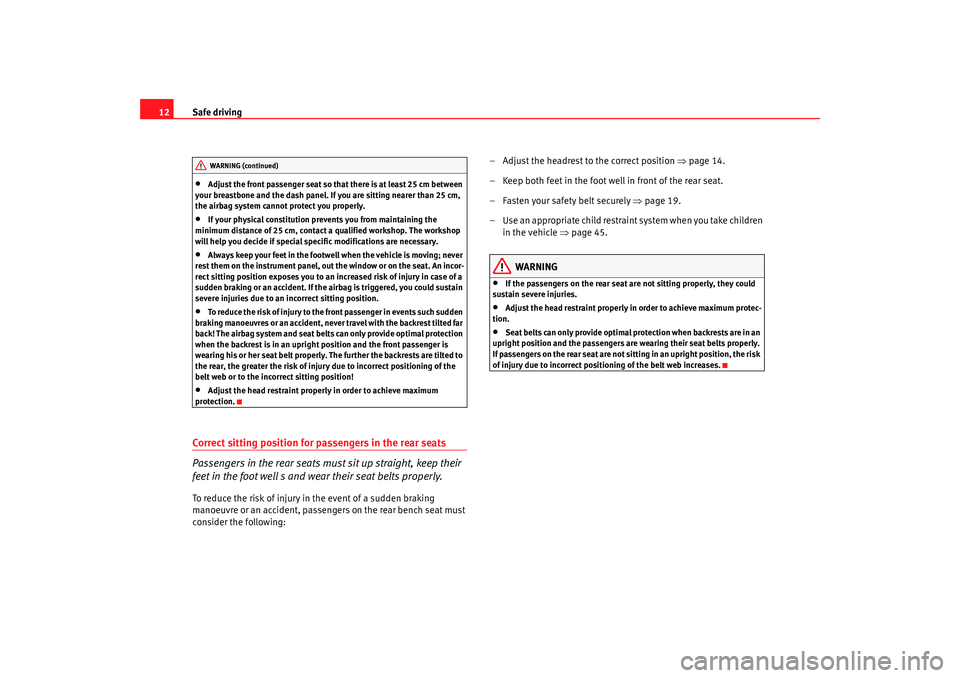
Safe driving
12•
Adjust the front passenger seat so th at there is at least 25 cm between
your breastbone and the dash panel. If you are sitting nearer than 25 cm,
the airbag system cannot protect you properly.
•
If your physical constitution prevents you from maintaining the
minimum distance of 25 cm, contact a qualified workshop. The workshop
will help you decide if special specific modifications are necessary.
•
Always keep your feet in the footwell when the vehicle is moving; never
rest them on the instrument panel, out the window or on the seat. An incor-
rect sitting position exposes you to an increased risk of injury in case of a
sudden braking or an accident. If the airbag is triggered, you could sustain
severe injuries due to an incorrect sitting position.
•
To reduce the risk of injury to the front passenger in events such sudden
braking manoeuvres or an accident, never travel with the backrest tilted far
back! The airbag system and seat belts can only provide optimal protection
when the backrest is in an upright position and the front passenger is
wearing his or her seat belt properly. The further the backrests are tilted to
the rear, the greater the risk of injury due to incorrect positioning of the
belt web or to the incorrect sitting position!
•
Adjust the head restraint properly in order to achieve maximum
protection.
Correct sitting position for passengers in the rear seats
Passengers in the rear seats must sit up straight, keep their
feet in the foot well s and wear their seat belts properly.To reduce the risk of injury in the event of a sudden braking
manoeuvre or an accident, passengers on the rear bench seat must
consider the following: – Adjust the headrest to the correct position
⇒page 14.
– Keep both feet in the foot well in front of the rear seat.
– Fasten your safety belt securely ⇒page 19.
– Use an appropriate child restraint system when you take children in the vehicle ⇒page 45.
WARNING
•
If the passengers on the rear seat are not sitting properly, they could
sustain severe injuries.
•
Adjust the head restraint properly in order to achieve maximum protec-
tion.
•
Seat belts can only provide optimal protection when backrests are in an
upright position and the passengers ar e wearing their seat belts properly.
If passengers on the rear seat are not sitting in an upright position, the risk
of injury due to incorrect positioning of the belt web increases.
WARNING (continued)
leon_ingles Seite 12 Montag, 26. Januar 2009 4:29 16
Page 16 of 293
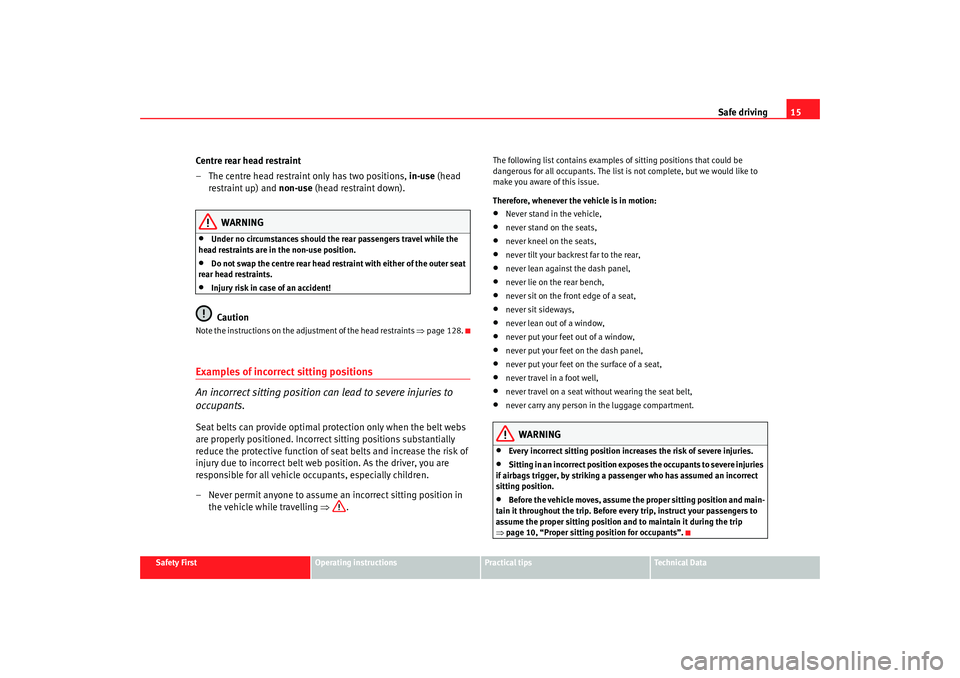
Safe driving15
Safety First
Operating instructions
Practical tips
Te c h n i c a l D a t a
Centre rear head restraint
– The centre head restraint only has two positions, in-use (head
restraint up) and non-use (head restraint down).
WARNING
•
Under no circumstances should the rear passengers travel while the
head restraints are in the non-use position.
•
Do not swap the centre rear head restraint with either of the outer seat
rear head restraints.
•
Injury risk in case of an accident!Caution
Note the instructions on the adjustment of the head restraints ⇒page 128.Examples of incorrect sitting positions
An incorrect sitting position can lead to severe injuries to
occupants.Seat belts can provide optimal protection only when the belt webs
are properly positioned. Incorrect sitting positions substantially
reduce the protective function of seat belts and increase the risk of
injury due to incorrect belt web position. As the driver, you are
responsible for all vehicle occupants, especially children.
– Never permit anyone to assume an incorrect sitting position in
the vehicle while travelling ⇒.
The following list contains examples of sitting positions that could be
dangerous for all occupants. The list is not complete, but we would like to
make you aware of this issue.
Therefore, whenever the vehicle is in motion:•
Never stand in the vehicle,
•
never stand on the seats,
•
never kneel on the seats,
•
never tilt your backrest far to the rear,
•
never lean against the dash panel,
•
never lie on the rear bench,
•
never sit on the front edge of a seat,
•
never sit sideways,
•
never lean out of a window,
•
never put your feet out of a window,
•
never put your feet on the dash panel,
•
never put your feet on the surface of a seat,
•
never travel in a foot well,
•
never travel on a seat without wearing the seat belt,
•
never carry any person in the luggage compartment.
WARNING
•
Every incorrect sitting position increases the risk of severe injuries.
•
Sitting in an incorrect position exposes the occupants to severe injuries
if airbags trigger, by striking a passenger who has assumed an incorrect
sitting position.
•
Before the vehicle moves, assume the proper sitting position and main-
tain it throughout the trip. Before every trip, instruct your passengers to
assume the proper sitting position and to maintain it during the trip
⇒ page 10, “Proper sitting position for occupants”.
leon_ingles Seite 15 Montag, 26. Januar 2009 4:29 16
Page 20 of 293
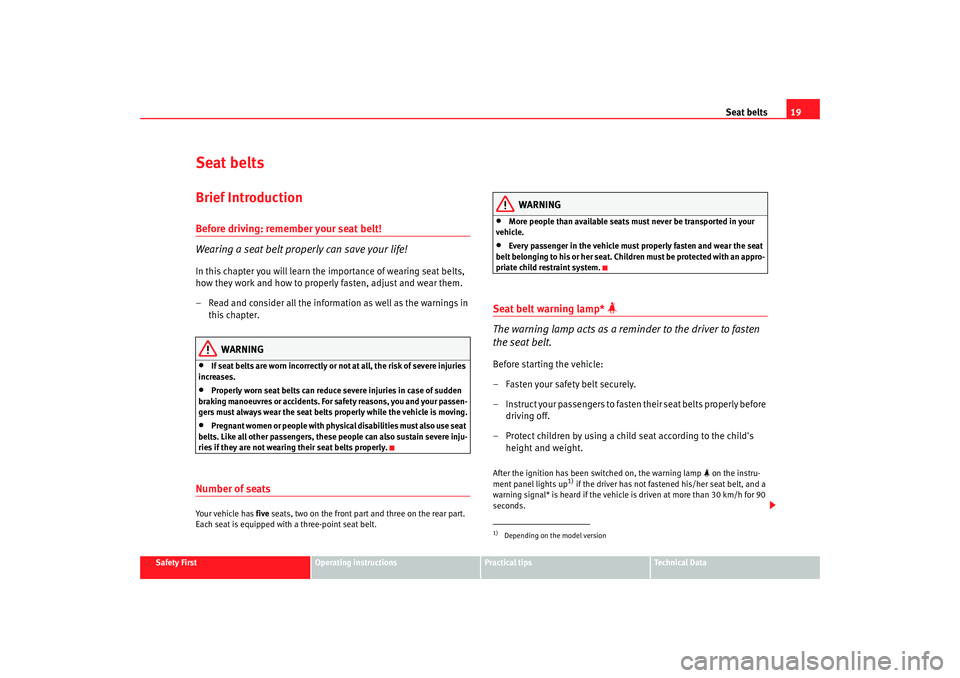
Seat belts19
Safety First
Operating instructions
Practical tips
Te c h n i c a l D a t a
Seat beltsBrief IntroductionBefore driving: remember your seat belt!
Wearing a seat belt properly can save your life!In this chapter you will learn the importance of wearing seat belts,
how they work and how to properly fasten, adjust and wear them.
– Read and consider all the information as well as the warnings in
this chapter.
WARNING
•
If seat belts are worn incorrectly or not at all, the risk of severe injuries
increases.
•
Properly worn seat belts can reduce severe injuries in case of sudden
braking manoeuvres or accidents. For safety reasons, you and your passen-
gers must always wear the seat belts properly while the vehicle is moving.
•
Pregnant women or people with physical disabilities must also use seat
belts. Like all other passengers, these people can also sustain severe inju-
ries if they are not wearing their seat belts properly.
Number of seatsYour vehicle has five seats, two on the front part and three on the rear part.
Each seat is equipped with a three-point seat belt.
WARNING
•
More people than available seats must never be transported in your
vehicle.
•
Every passenger in the vehicle must properly fasten and wear the seat
belt belonging to his or her seat. Chil dren must be protected with an appro-
priate child restraint system.
Seat belt warning lamp*
The warning lamp acts as a reminder to the driver to fasten
the seat belt.Before starting the vehicle:
– Fasten your safety belt securely.
– Instruct your passengers to fasten their seat belts properly before driving off.
– Protect children by using a child seat according to the child's height and weight.After the ignition has been switched on, the warning lamp on the instru-
ment panel lights up
1) if the driver has not fastened his/her seat belt, and a
warning signal* is heard if the vehicle is driven at more than 30 km/h for 90
seconds.
1)Depending on the model version
leon_ingles Seite 19 Montag, 26. Januar 2009 4:29 16
Page 25 of 293
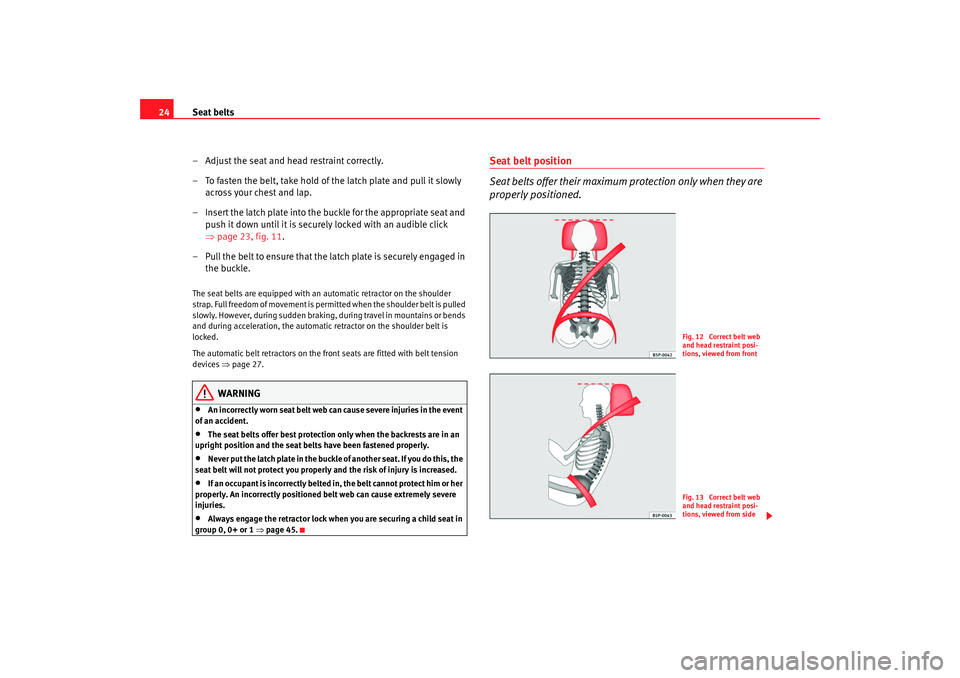
Seat belts
24
– Adjust the seat and head restraint correctly.
– To fasten the belt, take hold of the latch plate and pull it slowly across your chest and lap.
– Insert the latch plate into the buckle for the appropriate seat and push it down until it is securely locked with an audible click
⇒page 23, fig. 11 .
– Pull the belt to ensure that the latch plate is securely engaged in the buckle.The seat belts are equipped with an automatic retractor on the shoulder
strap. Full freedom of movement is perm itted when the shoulder belt is pulled
slowly. However, during sudden braking, during travel in mountains or bends
and during acceleration, the automatic retractor on the shoulder belt is
locked.
The automatic belt retractors on the front seats are fitted with belt tension
devices ⇒page 27.
WARNING
•
An incorrectly worn seat belt web c an cause severe injuries in the event
of an accident.
•
The seat belts offer best protection only when the backrests are in an
upright position and the seat belts have been fastened properly.
•
Never put the latch plate in the buckle of another seat. If you do this, the
seat belt will not protect you properly and the risk of injury is increased.
•
If an occupant is incorrectly belted in, the belt cannot protect him or her
properly. An incorrectly positioned belt web can cause extremely severe
injuries.
•
Always engage the retractor lock when you are securing a child seat in
group 0, 0+ or 1 ⇒page 45.
Seat belt position
Seat belts offer their maximum protection only when they are
properly positioned.
Fig. 12 Correct belt web
and head restraint posi-
tions, viewed from frontFig. 13 Correct belt web
and head restraint posi-
tions, viewed from side
leon_ingles Seite 24 Montag, 26. Januar 2009 4:29 16
Page 26 of 293
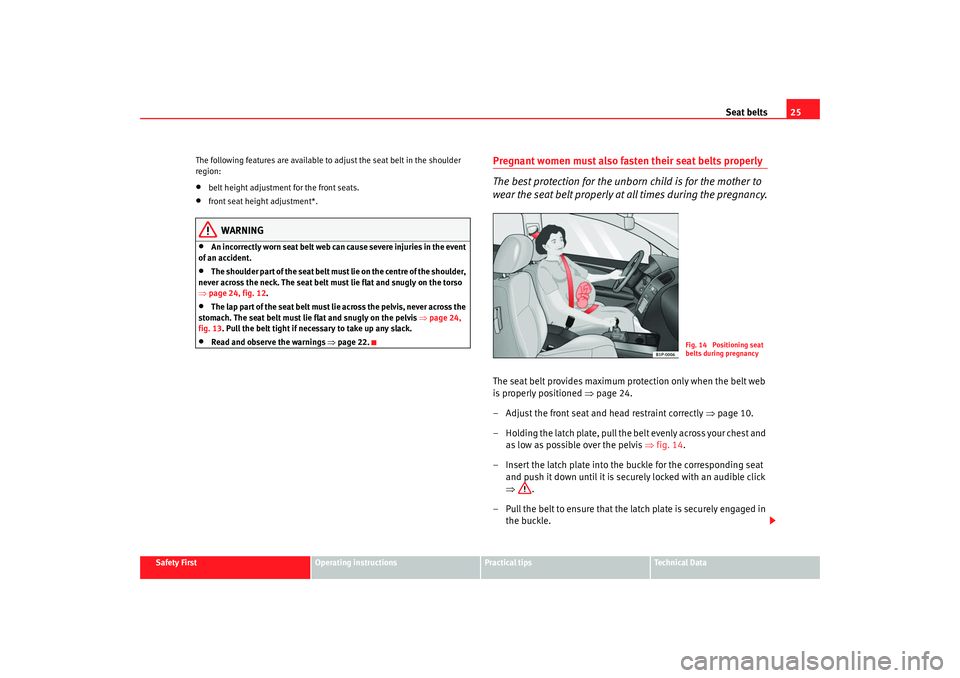
Seat belts25
Safety First
Operating instructions
Practical tips
Te c h n i c a l D a t a
The following features are available to adjust the seat belt in the shoulder
region:
•
belt height adjustment
for the front seats.
•
front seat height adjustment*.
WARNING
•
An incorrectly worn seat belt web can cause severe injuries in the event
of an accident.
•
The shoulder part of the seat belt must lie on the centre of the shoulder,
never across the neck. The seat belt must lie flat and snugly on the torso
⇒ page 24, fig. 12 .
•
The lap part of the seat belt must l ie across the pelvis, never across the
stomach. The seat belt must lie flat and snugly on the pelvis ⇒page 24,
fig. 13 . Pull the belt tight if necessary to take up any slack.
•
Read and observe the warnings ⇒page 22.
Pregnant women must also fasten their seat belts properly
The best protection for the unborn child is for the mother to
wear the seat belt properly at all times during the pregnancy.The seat belt provides maximum protection only when the belt web
is properly positioned ⇒page 24.
– Adjust the front seat and head restraint correctly ⇒page 10.
– Holding the latch plate, pull the belt evenly across your chest and as low as possible over the pelvis ⇒ fig. 14.
– Insert the latch plate into the buckle for the corresponding seat and push it down until it is securely locked with an audible click
⇒ .
– Pull the belt to ensure that the latch plate is securely engaged in the buckle.
Fig. 14 Positioning seat
belts during pregnancy
leon_ingles Seite 25 Montag, 26. Januar 2009 4:29 16
Page 30 of 293
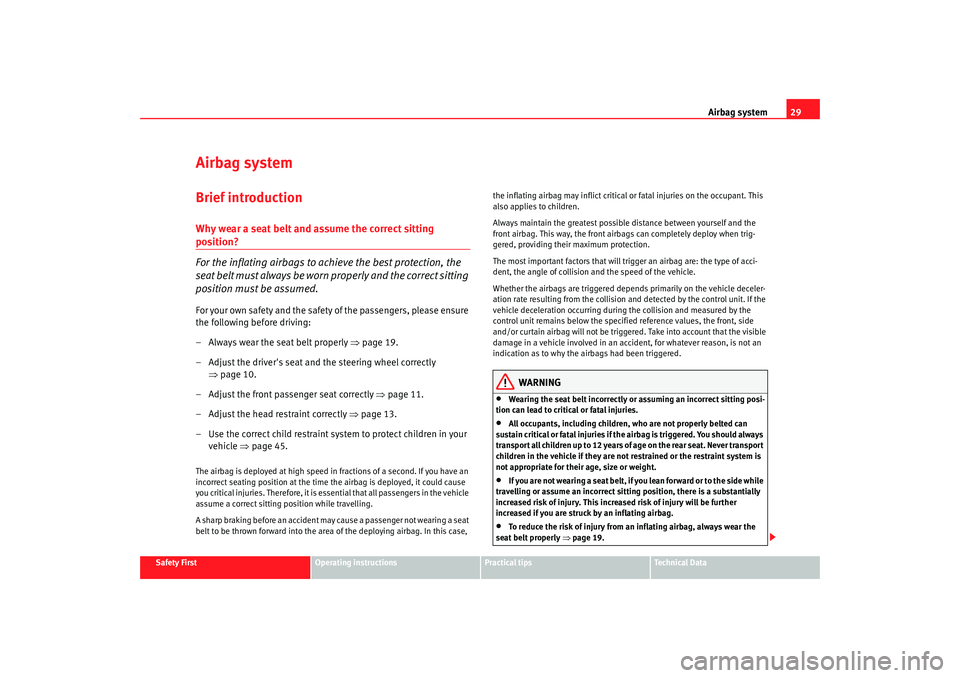
Airbag system29
Safety First
Operating instructions
Practical tips
Te c h n i c a l D a t a
Airbag systemBrief introductionWhy wear a seat belt and assume the correct sitting position?
For the inflating airbags to achieve the best protection, the
sea t b el t m u st a l w ay s be w o rn p ro p e rly a n d t h e co rrec t s i tt i ng
position must be assumed.For your own safety and the safety of the passengers, please ensure
the following before driving:
– Always wear the seat belt properly ⇒page 19.
– Adjust the driver's seat and the steering wheel correctly ⇒page 10.
– Adjust the front passenger seat correctly ⇒page 11.
– Adjust the head restraint correctly ⇒page 13.
– Use the correct child restraint system to protect children in your vehicle ⇒ page 45.The airbag is deployed at high speed in fractions of a second. If you have an
incorrect seating position at the time the airbag is deployed, it could cause
you critical injuries. Therefore, it is essential that all passengers in the vehicle
assume a correct sitting position while travelling.
A sharp braking before an accident may cause a passenger not wearing a seat
belt to be thrown forward into the area of the deploying airbag. In this case, the inflating airbag may inflict critical or fatal injuries on the occupant. This
also applies to children.
Always maintain the greatest possible distance between yourself and the
front airbag. This way, the front airbag
s can completely deploy when trig-
gered, providing their maximum protection.
The most important factors that will trigger an airbag are: the type of acci-
dent, the angle of collision and the s peed of the vehicle.
Whether the airbags are triggered depends primarily on the vehicle deceler-
ation rate resulting from the collision an d detected by the control unit. If the
vehicle deceleration occurring during the collision and measured by the
control unit remains below the specifie d reference values, the front, side
and/or curtain airbag will not be triggered. Take into account that the visible
damage in a vehicle involved in an ac cident, for whatever reason, is not an
indication as to why the airbags had been triggered.
WARNING
•
Wearing the seat belt incorrectly or assuming an incorrect sitting posi-
tion can lead to critical or fatal injuries.
•
All occupants, including children, who are not properly belted can
sustain critical or fatal injuries if the airbag is triggered. You should always
transport all children up to 12 years of age on the rear seat. Never transport
children in the vehicle if they are not restrained or the restraint system is
not appropriate for their age, size or weight.
•
If you are not wearing a seat belt, if you lean forward or to the side while
travelling or assume an incorrect sitt ing position, there is a substantially
increased risk of injury. This increased risk of injury will be further
increased if you are struck by an inflating airbag.
•
To reduce the risk of injury from an inflating airbag, always wear the
seat belt properly ⇒page 19.
leon_ingles Seite 29 Montag, 26. Januar 2009 4:29 16
Page 37 of 293
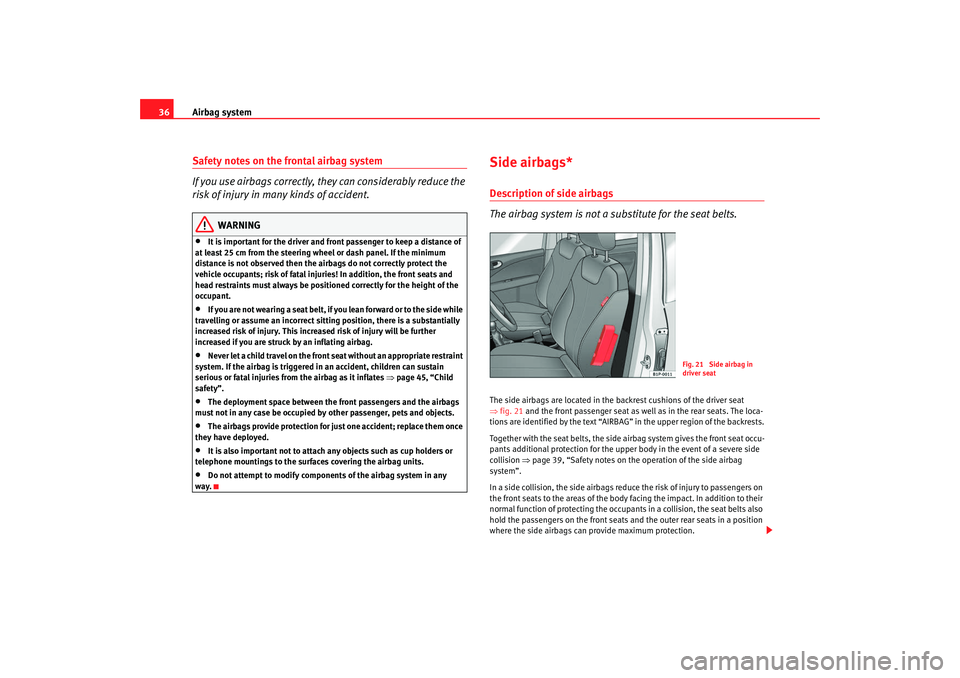
Airbag system
36Safety notes on the frontal airbag system
If you use airbags correctly, they can considerably reduce the
risk of injury in many kinds of accident.
WARNING
•
It is important for the driver and front passenger to keep a distance of
at least 25 cm from the steering wheel or dash panel. If the minimum
distance is not observed then the airbags do not correctly protect the
vehicle occupants; risk of fatal injuries! In addition, the front seats and
head restraints must always be positioned correctly for the height of the
occupant.
•
If you are not wearing a seat belt, if you lean forward or to the side while
travelling or assume an incorrect sitting position, there is a substantially
increased risk of injury. This increased risk of injury will be further
increased if you are struck by an inflating airbag.
•
Never let a child travel on the front seat without an appropriate restraint
system. If the airbag is triggered in an accident, children can sustain
serious or fatal injuries from the airbag as it inflates ⇒page 45, “Child
safety”.
•
The deployment space between the front passengers and the airbags
must not in any case be occupied by other passenger, pets and objects.
•
The airbags provide protection for just one accident; replace them once
they have deployed.
•
It is also important not to attach any objects such as cup holders or
telephone mountings to the surfaces covering the airbag units.
•
Do not attempt to modify components of the airbag system in any
way.
Side airbags*Description of side airbags
The airbag system is not a substitute for the seat belts.The side airbags are located in the backrest cushions of the driver seat
⇒ fig. 21 and the front passenger seat as well as in the rear seats. The loca-
tions are identified by the text “AIRBAG” in the upper region of the backrests.
Together with the seat belts, the side airbag system gives the front seat occu-
pants additional protection for the upper body in the event of a severe side
collision ⇒page 39, “Safety notes on the operation of the side airbag
system”.
In a side collision, the side airbags reduce the risk of injury to passengers on
the front seats to the areas of the body facing the impact. In addition to their
normal function of protecting the occupants in a collision, the seat belts also
hold the passengers on the front seats and the outer rear seats in a position
where the side airbags can provide maximum protection.
Fig. 21 Side airbag in
driver seat
leon_ingles Seite 36 Montag, 26. Januar 2009 4:29 16